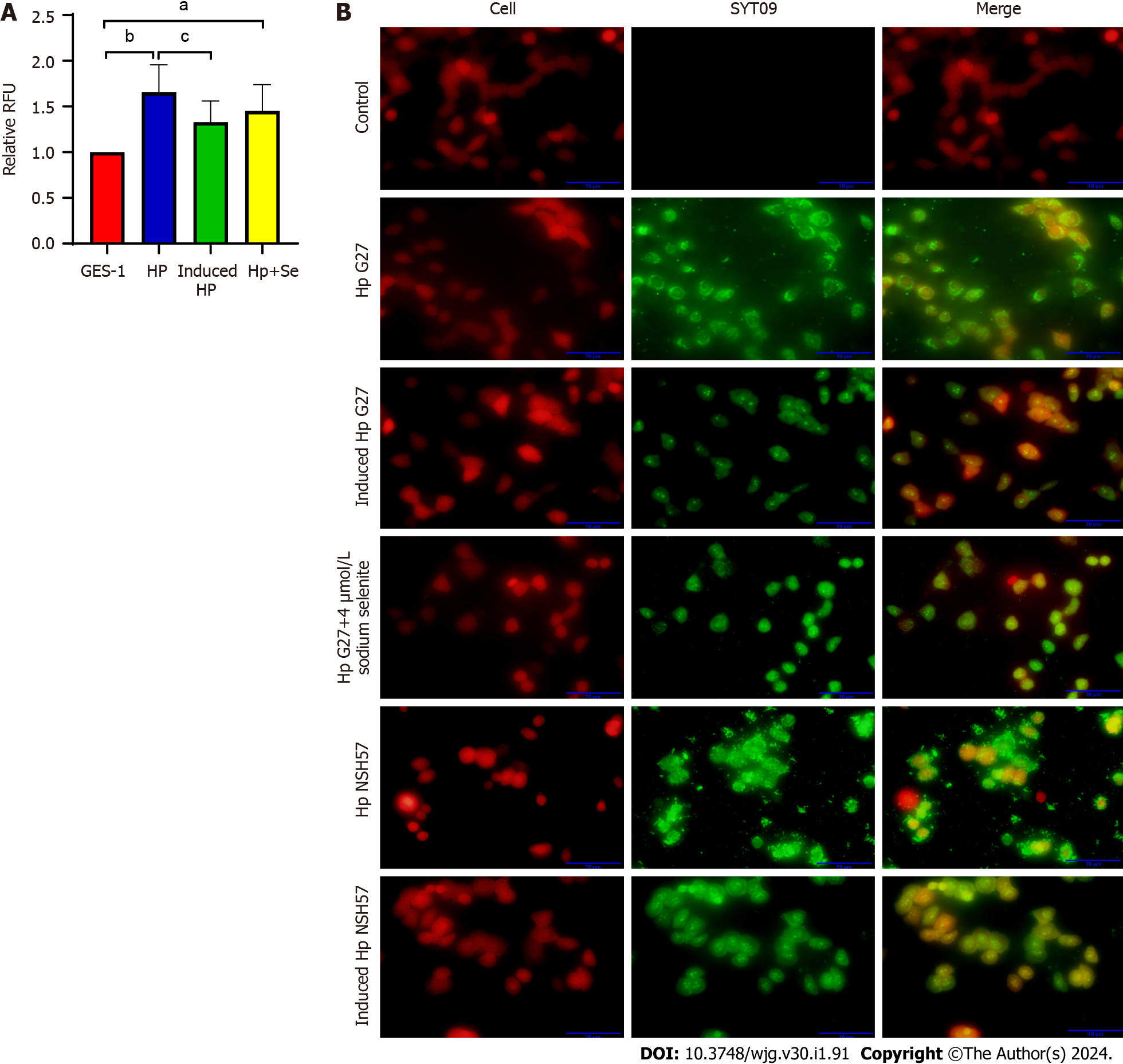Copyright
©The Author(s) 2024.
World J Gastroenterol. Jan 7, 2024; 30(1): 91-107
Published online Jan 7, 2024. doi: 10.3748/wjg.v30.i1.91
Published online Jan 7, 2024. doi: 10.3748/wjg.v30.i1.91
Figure 1 Induction of Helicobacter pylori with sodium selenite downregulates cytotoxin-associated protein A and vacuolating cytotoxin gene A expression.
A: Effect of induction of the Hp G27 strain with sodium selenite on cytotoxin-associated protein A (CagA) for 1-6 cycles; B: Effect of induction of the Hp G27 strain with sodium selenite on vacuolating cytotoxin gene A (VacA) for 1-6 cycles; C-E: Effect of induction of the Hp G27 strain with sodium selenite on the CagA and VacA proteins for 1, 3, and 6 cycles; F: Effect of induction of the Hp G27 strain with 4 mol/L sodium selenite on CagA and VacA of the NSH57 strain for 6 cycles; G and H: Effect of induction of the NSH57 strain with 4 μmol/L sodium selenite on CagA and VacA protein. aP < 0.05; bP < 0.01.
Figure 2 Effect of sodium selenite on the Helicobacter pylori transcriptome.
A: Half inhibitory concentration of sodium selenite given to Helicobacter pylori; B: RNA sequencing correlation examination; C: Principal component analysis of the transcriptome; D: The Venn diagram of differentially expressed genes (DEGs); E: Cluster analysis of DEGs; F-H: Gene set enrichment analysis of DEGs between treatment groups; I: Epithelial cell signal transduction pathways associated with H. pylori infection.
Figure 3 Verification of differentially expressed genes and changes in screened differentially expressed genes following induction.
A: Quantitative PCR verification of differentially expressed genes (DEGs); B-F: Changes in DEGs after induction with 4 μmol/L sodium selenite for 1-5 cycles. aP < 0.05; bP < 0.01.
Figure 4 Induction with sodium selenite decreased the adhesion ability of Helicobacter pylori strains.
A: Number of cells adhering to Helicobacter pylori strains was determined using a fluorescence microscope; B: Number of cells adhering to H. pylori strains was determined with the SYTO 9 stain. aP < 0.05; bP < 0.01; cP < 0.05.
Figure 5 Induction with sodium selenite decreased Helicobacter pylori-induced inflammation.
A-C: Expression of IL-1β (A), IL-6 (B), and TNF-α (C) in Helicobacter pylori-infected mice after induction; D: Gastric mucosal inflammation in mice with acute gastritis; E: H. pylori colonization in the stomach of mice with acute gastritis. aP < 0.05; bP < 0.01; cP < 0.05; dP < 0.01; eP < 0.05; fP < 0.01; hP < 0.01.
- Citation: Qin C, Huang GR, Guan AX, Zhou WT, Chen H, Luo PP, Luo XK, Huang YQ, Huang ZS. Mechanistic research: Selenium regulates virulence factors, reducing adhesion ability and inflammatory damage of Helicobacter pylori. World J Gastroenterol 2024; 30(1): 91-107
- URL: https://www.wjgnet.com/1007-9327/full/v30/i1/91.htm
- DOI: https://dx.doi.org/10.3748/wjg.v30.i1.91

















